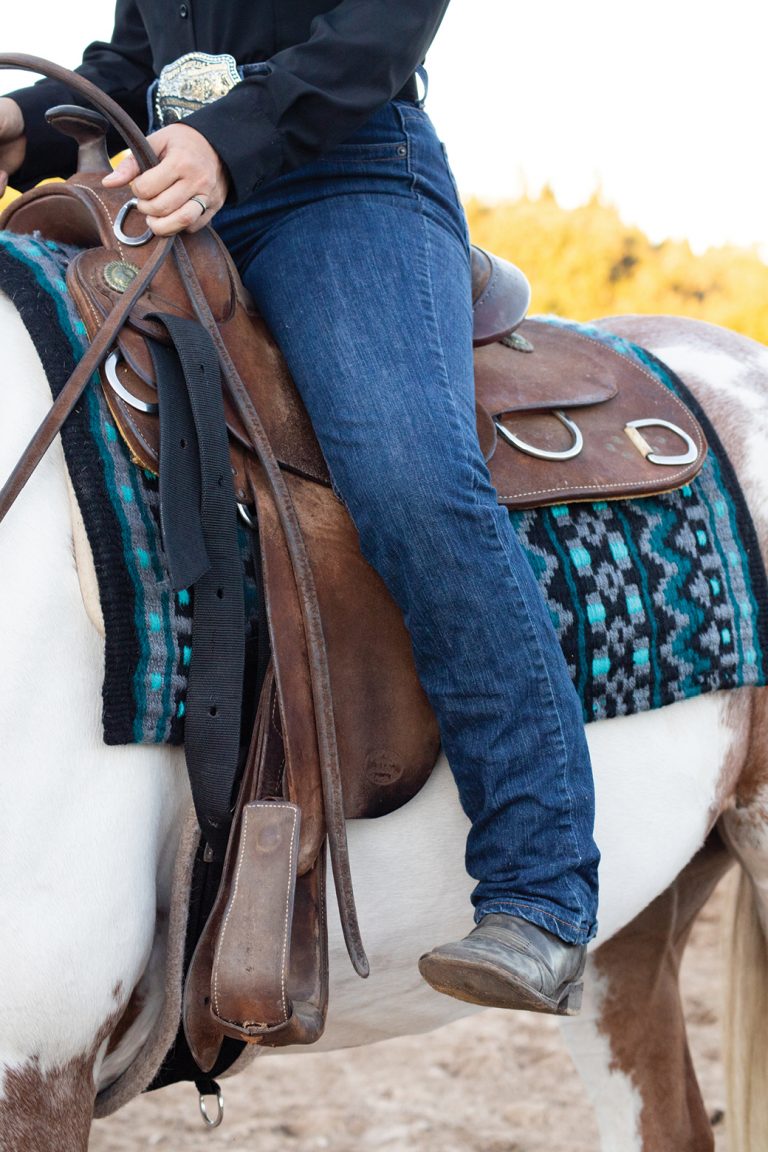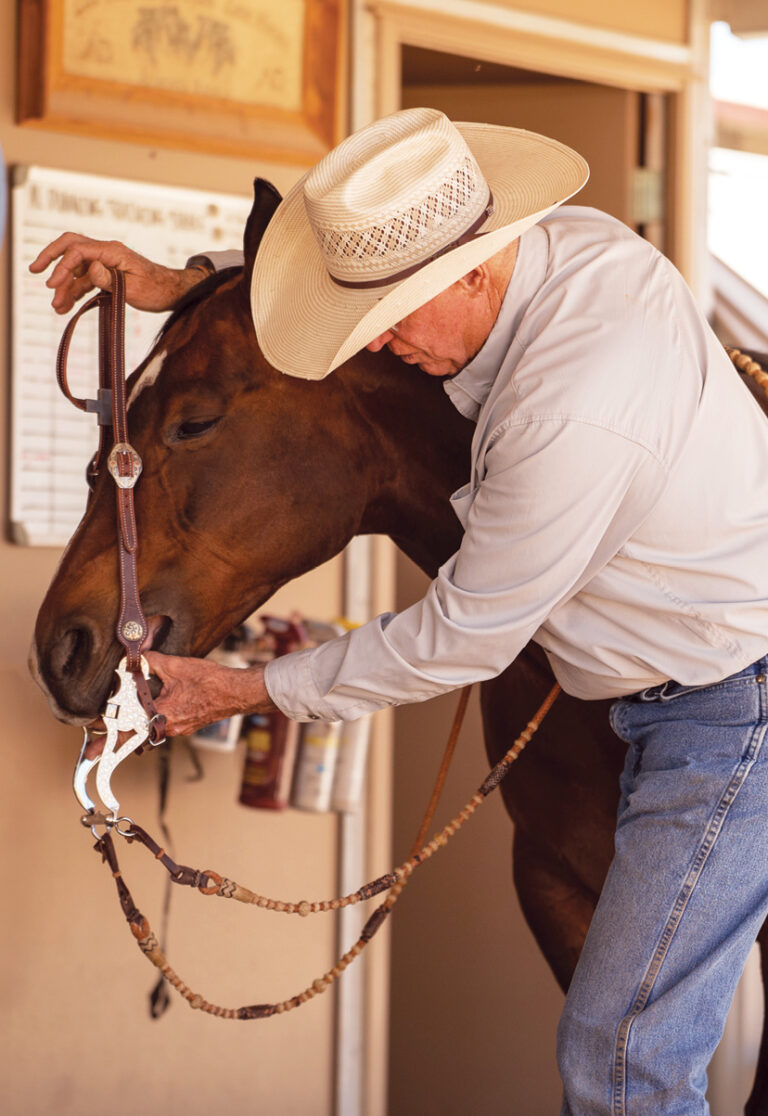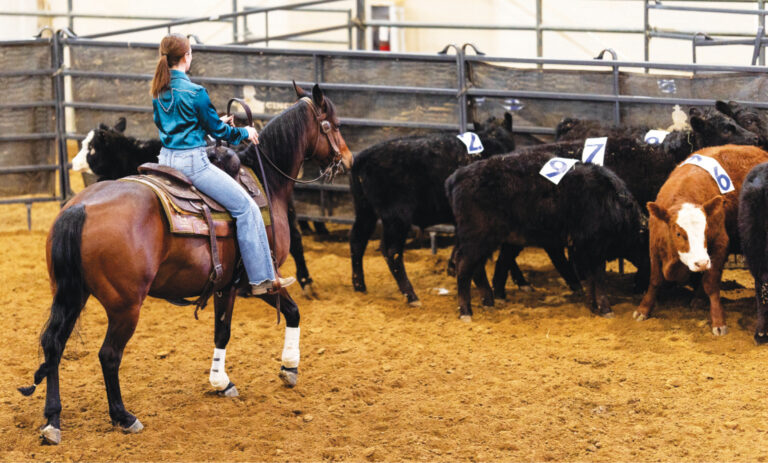Why Romal Reins?
Romal reins might seem like a trendy fad of the moment, because you see them in so many of the ranch classes, as well as working cow horse and reining. They give a distinctly traditional Western look. But they trace back to the West Coast vaqueros who spent up to seven years training their horses to be “straight up in the bridle,” guided with romal reins. To this day, romal reins signify an extremely well-trained horse, because there’s no cheating with them. Professionals reach for them for the straightness they can achieve with their horses when keeping the horse between the reins is of utmost importance. For fast-paced riding, as with working cow horse and when working cattle on a ranch, romal reins offer an added safety element, because you can’t drop a rein in the heat of the moment.

Interested in giving romals a try but unsure where to start? We spoke with two experts to help you choose and use the traditional tack correctly and in the best way for your horse.
Bill Black first took up braiding at age 10, under the guidance of his father. What started with sisal twine and a four-strand round braid turned into a career of braiding romal reins, hackamores, headstalls, and more for the best hands in the Western industry. He and his wife, Teresa, braid and sell their gear from their place in southeast Oregon.
Laurel Denton grew up on a ranch in Arizona and trains Quarter Horses for working cow horse and ranch events from her family ranch in Skull Valley. She’s a multiple-time AQHA world champion and a well-respected judge and educator when it comes to Western traditions and training techniques.
With their combined knowledge, you’ll be equipped to pick a set of romal reins and use them correctly.
Choosing Your Romal Reins
When picking your reins, craftsmanship and the type and quality of hide make a huge difference in the end product, from the feel you’ll have in your hands to the response you’ll get from your horse.
When picking what’s best for your needs, your decisions start with the hide and construction of the romal reins.
“Most romal reins are usually eight or 12 strings,” Black advises. “Anything less can be pretty stiff.”
This refers to the number of strands—or plaits—in the braid, which influences the pliability of the reins and the feel in your hand. The feel of the reins also depends on the core the maker braided around.
“In my opinion, the core should be braided rawhide; 12- to 18-braid reins can have a harness leather core,” Black shares. “A reata or leather core gives the romal life. I don’t like to see romal reins that I can coil like a lasso rope. That means the core is probably something like nylon rope. A rope core also draws moisture that can rot the braided rawhide from the inside out. Horses sweat, sometimes we have to ride in the rain—once that moisture gets into a rope core, it takes quite a while to dry and can lead to rot.”
Hide Options
Hides for braiding vary from cowhide/rawhide to kangaroo.
“Kangaroo is about the strongest leather out there for as thin as it is,” Black says. “I braid them 12 strands on a core of harness leather. They’re a higher price point, but they have a good feel in your hand.”
One key hide tip: Black advises looking for a golden-colored finish on the rawhide. He says if the rawhide is more of a white color, it’s likely the maker didn’t get all of the chemicals rinsed out when preparing the hide.
Once you’ve considered hides and the feel in your hand, you’ll also need to think about length. Your horse’s size plays a role in this, as well as if you plan to use rein chains or have the braided leather attach directly to your bit either with leather buttons or metal snaps.
“In my experience, 48 inches is the most common length with people who show horses competitively,” Black shares. “Some stretch it to 52 inches, but that’s really long, in my opinion. Generally, 48-inch reins connect directly to the bit without rein chains. If I’m using rein chains to get a quicker signal to my horse, I ride 42-inch reins with 6- to 10-inch rein chains. It’s pretty common to see 40- or 42-inch reins when using chains. I’ve braided some that are 38 inches, but they require pretty long chains.”
Weight of Your Reins
Weight is also a consideration when choosing your romal reins. As a general guideline, Black says the reins (the split pieces that connect to the bit) should weigh the same as the romal (the single, longer piece that you hold in your off hand). Additionally, he advises that the reins and chains (if you use them) together should weigh about the same as the bit. Black notes that these equations are important for balance in your gear as well as for a correct signal. Keep this in mind if you’ll add silver ferrules on your reins, because you’ll need to consider that they add extra heft that must be balanced with your bit.
“It used to be that your bitmaker wouldn’t start creating your bit until your reins were done so the bit could be the correct weight,” Black shares.
Finally, Black notes a safety concern to watch out for when choosing your romal reins.
“A lot of people who show, ride with spurs that have smaller rowels,” he explains. “There’s a loop where the popper (the end of the romal) connects that can catch on your spurs if it’s not constructed correctly. You have a loop where the romal connects to the reins, and your romal should run down your leg with the popper flat against your lower leg rather than perpendicular to it.”
Using Your Romal Reins
Denton uses romal reins daily in her training as well as in the show pen. → She’s an AQHA and NRCHA judge, so she’s acutely aware of that organizations’ rules regarding how to use romal reins. She advises consulting your rulebook for any requirements under the organization n which you compete.
“To start, you hold the reins in your left hand, just below the loop that connects the reins to the romal,” Denton begins. “Position your hand like you’re holding an ice cream cone—in a loose fist with your thumb upward. I say that your hold on the reins should be like you’re handling a baby bird. This allows you to pull slack through your hand and release it quickly. The knots on your reins add weight that allows the reins to quickly slip through your hand and release the pressure from your horse’s mouth.”
Consider Your Horse
Under most rules, you can’t hold your reins with an open fist or with a finger between your reins. The only exception is while riding in a two-rein outfit. It’s also incorrect to loop the romal forward in front of your hand. It interferes with the direct line that romal reins provide to your horse’s mouth.
Denton agrees with Black that the length of your reins depends on the size of your horse.
“Many ranch riders and reiners are shorter-necked,” she explains, “so longer romals will be too long for many of them. I usually prefer mine to measure 46 or 48 inches. You can use chains if you need to add length, but remember that romal reins aren’t meant to have a lot of slack when using rein chains. You don’t want a lot of sway in the reins, because that interferes with your communication to the mouth.”
Use Them Properly
Denton appreciates the quick release provided by romal reins. You can pull your slack to make contact for a correction and immediately release when your horse is correct.
“Horses live in the moment,” she explains. “Your correction must be quick and decisive with an immediate reward when your horse responds. Romals are very good for that.”
When guiding your horse with romal reins, Denton notes that your rein hand shouldn’t move much. It should stay in a small box above your saddle horn, moving left or right, forward or back.
“It’s important not to over-rein your horse or turn your hand, you’ll shorten your rein on one side,” she shares. “That defeats the purpose of the romal reins and removes the straightness they provide.”
Finally, as a judge, Denton says many people ask her if she prefers to see romal reins in ranch classes.
“It doesn’t matter to me as a judge,” she explains. “What matters is what works best for you and what’s best for your horse.”
Care for Your Romal Reins
You’ve invested in a quality set of romal reins. They’re gorgeous, and you want to keep them that way so you can use them for the long haul. Care of your reins is critical to keeping them in their best shape for the feel and look you want.
Take them inside. Especially if you live in a humid climate, keep your rawhide gear inside, where the climate is controlled. Wet climates can lead to rotting the rawhide.
Don’t assume your trailer, tack room, or home is mice-free. Mice will destroy your rawhide gear beyond repair. Be sure to keep your gear away from known mice havens.
Keep them away from dogs, too. Dogs love rawhide as much as mice and can cause as much or more damage. Be wary if you condition your rawhide with beef fat. Professional braider Bill Black says that’s like a steak dinner to your dog.
Protect Your Reins
Condition your rawhide at least once per year. Use a good-quality rawhide cream or beef fat (Black’s preferred method) to condition your rawhide gear annually. It keeps it soft and supple, preventing breaking that can come from dryness, dirt, and wear and tear.
Hang your romal reins properly. When not in use, hang your reins so the romal and reins are straight—not looped.
Put in the effort if they get wet. Whether from a sweaty neck or a light rain, provide care for your romal reins if they get wet. Keep the reins and the romal straight to keep the braiding uniform. You might need to hang a weight at the end to keep them straight while they dry. Once they’re dry, condition the rawhide to keep its feel.
If they dry out, use a trash bag. If your rawhide gear gets dry, apply conditioning cream. Then, place the reins in a black trash bag, and leave it out in the sun to work the cream into the rawhide and return the reins’ suppleness.




